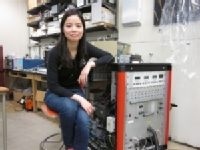Proton Transfer Reaction Linear Ion Trap Mass Spectrometry

Xiong, with the PTR-LIT MS.
The linear ion trap can store, accumulate and dissociate ions, therefore providing an effective way to differentiate isobaric and isomeric species, which are not uncommon in the atmosphere.
In PTR-LIT, hydronium ([H3O]+) ions are created in a corona discharge source and extracted into the drift tube where they react with VOCs leading to predominately (M+H)+ions with little fragmentation. The LIT has 200mm quadrupole rods of 8mm diameter and two end cap electrodes that controlfilling and ejection stages. Isobaric compounds can be isolated, fragmented, and scanned out of the trap. Ions are sequentially ejected by ramping the Rf voltage and are then bent orthogonally to an SEM detector. Applying dipolar excitation increases resolution and allows for CID experiments. Since most isobaric species have different fragmentation patterns, isobaric species can be identified and quantified.
Major publications on PTR-LIT:
Levi H. Mielke, Kerri A. Pratt, Paul B. Shepson, Scott A. McLuckey, Armin Wisthaler, and Armin Hansel, Analytical Chemistry 2010 82 (19), 7952-7957
Levi H. Mielke, David E. Erickson, Scott A. McLuckey, Markus Müller, Armin Wisthaler, Armin Hansel, and Paul B. Shepson, Analytical Chemistry 2008 80 (21), 8171-8177
